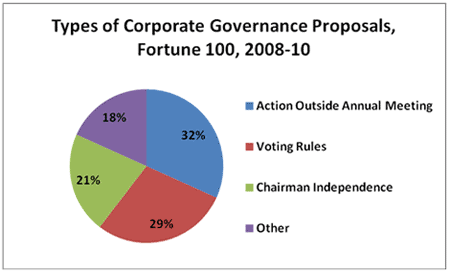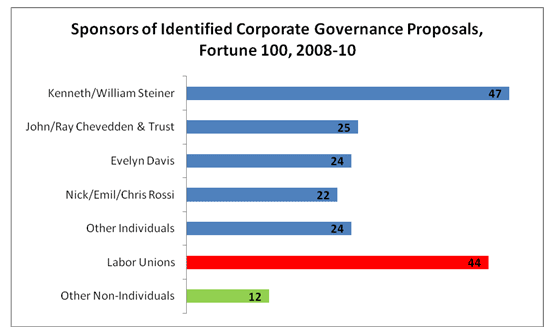Manhattan Institute Proxy Monitor Finding 3
Corporate Governance
Board Leadership, Voting Rules, and
Shareholder Latitude are Key Issues
Individual Shareholder Activists Dominate
Overall, but Unions Lead Charge on Board-Chairman Independence
The Manhattan Institute’s
ProxyMonitor.org database contains information on shareholder proposals
submitted to Fortune 100 companies, from 2008 through 2010, as part of proxy
statements voted on in corporate annual meetings. These proposals have garnered
increased attention in recent years, and various provisions of the
2010 Dodd-Frank
Wall Street Reform and Consumer Protection Act have increased shareholder power
over corporate boards of directors.[1]
This spring, in
anticipation of the 2011 proxy season, the Manhattan Institute is releasing
“findings” drawn from the Proxy Monitor database. Our first finding, focused on
executive compensation, showed the prominent role played by labor-union pension
funds in sponsoring proposals tied to executive pay.[2] Our second finding, focused on shareholder
proposals related to social and policy goals, found an increased emphasis on
corporate political spending, expected to grow in the wake of the Supreme
Court’s Citizens United[3]
decision.[4]
This finding focuses on
shareholder proposals involving more traditional corporate-governance questions,
such as voting rules, shareholders’ power to act between meetings, and board
leadership. While not as numerous as shareholder proposals related to various
social and political issues,[5] these types of proposals have shown
themselves much more likely to pass muster: as noted in an earlier Manhattan
Institute report,[6] 19 percent of corporate-governance-related shareholder
proposals submitted to
Fortune 100 companies between 2008 and 2010 were approved. While less
controversial, these proposals, when passed, have the potential to further
empower shareholder activists in other areas, particularly contested director
elections that may become more commonplace under “proxy access” rules
promulgated by the Securities and Exchange Commission pursuant to Section 971 of
Dodd-Frank.[7]
This Manhattan Institute
Proxy Monitor Finding looks more carefully at corporate-governance proposals
using data gathered from the Institute’s ProxyMonitor.org database to examine:
a) Major areas of focus for corporate-governance
proposals;
b) Key sponsors of corporate-governance proposals;
and
c)
Voting trends.
a) Major
areas of focus for corporate-governance proposals;
 From 2008 to 2010, shareholder proposals related to corporate governance
submitted to Fortune 100 companies were focused on three main issues:
shareholders’ power to call meetings or otherwise act by written consent outside
shareholder meetings; voting rules for electing directors and amending corporate
bylaws; and the independence of board chairmen (see graph left).
From 2008 to 2010, shareholder proposals related to corporate governance
submitted to Fortune 100 companies were focused on three main issues:
shareholders’ power to call meetings or otherwise act by written consent outside
shareholder meetings; voting rules for electing directors and amending corporate
bylaws; and the independence of board chairmen (see graph left).
In the last three full calendar years,
shareholders of Fortune 100 companies voted on 73 shareholder proposals
attempting to empower shareholders to act outside the annual meeting schedule.
Nine of these proposals would authorize shareholders to act by written consent
outside of annual meetings, and 64 would permit the owners of a certain
percentage of shares to call for special meetings. The proponents of these
proposals argue that permitting shareholders to act outside the annual-meeting
process is an important tool of shareholder governance, allowing shareholders to
elect new directors or otherwise take action when prompt shareholder
consideration is necessary. When management opposes such proposals, it is
usually on the grounds that such measures improperly empower a majority of
shareholders—as few as ten percent in recent proposals—to impose significant
costs on corporations and potentially advance an agenda contrary to the
interests of a majority of shareholders, who are protected by boards fulfilling
their fiduciary duties and who themselves already have the power to call special
meetings.
The second largest category of
corporate-governance proposals submitted for a vote at Fortune 100 companies in
that time period—66 proposals in total—involved changes to voting rules.
Specifically, these proposals called for simple-majority voting or for
cumulative voting. Twenty proposals called for adopting simple majority-voting
rules, such that directors in uncontested elections would have to obtain a
majority of votes to be seated, as well as—for some proposals—allowing
shareholders to amend corporate bylaws by simple majority vote. Supporters of
these proposals maintain that majority voting is an essential component of
shareholder power; opponents contend that at least for bylaw amendments,
supermajority voting requirements can preserve important long-run shareholder
interests. The most numerous category of voting-rule proposals called for
cumulative voting, which would allow shareholders to aggregate all their votes
in director elections in support of a single candidate. Supporters claim that
permitting such targeted voting would enable a clearer expression of shareholder
preferences in elections; opponents argue that cumulative-voting rules would
instead empower the election of “special interest” directors who would pursue
agendas that may conflict with the interests of most shareholders.
The third largest category of
corporate-governance proposals involved rules requiring that the corporation’s
board chairman be independent. Such rules would disqualify current and former
chief executives from holding board chairmanships. Forty-nine of these proposals
were submitted to a vote at Fortune 100 companies between 2008 and 2010.
Supporters of these proposals argue that an independent chairman is best able to
protect shareholders’ interests. Joint chairmen-CEOs, these supporters maintain,
face an inherent conflict between their management and shareholder-protection
roles. Opponents of these proposals argue that there is no one-size-fits-all
solution for board leadership. Combining the role of chaiman and CEO, these
opponents say, has a long history and can be more appropriate than separating
the positions, depending on a company’s circumstances, including the value added
by inside-management knowledge in leading board activities.
b) Key
sponsors of corporate-governance proposals
 Unlike executive-compensation and social-policy shareholder proposals,[8]
proposals related to corporate governance tend to be sponsored by individual
shareholder activists (see graph right).
Unlike executive-compensation and social-policy shareholder proposals,[8]
proposals related to corporate governance tend to be sponsored by individual
shareholder activists (see graph right).
A small number of shareholders—Evelyn Davis (the
largest sponsor of shareholder proposals overall), and the Steiner, Chevedden,
and Rossi families—dominate activity in this area, having sponsored 118 of the
198 identified corporate-governance proposals to have come to a vote at Fortune
100 companies from 2008 to 2010. All twenty-four of the proposals backed by Davis have called for cumulative-voting rules. The
other individual sponsors of corporate-governance proposals have backed a more
diverse array of proposals, focusing on voting rules and shareholder actions
outside the annual meeting, in addition to less-common proposals, like
reincorporation in North Dakota
(a state whose coporate-law regime is viewed by shareholder activists as among
the friendliest in the nation). Only one proposal among these large groups of
individual sponsors involved the independence of board chairmen, that sponsored
by the Chevedden Family Trust.
The principal sponsors of proposals calling for a separation of the roles of
board chairman and chief executive officer were instead labor unions, who
proposed 58 percent of all such proposals with an identified sponsor. The key
role played by unions in this area parallels their role as sponsors of
executive-compensation proposals.[9] Moreover, union support for such
proposals reinforces the view that unions’ activity in this arena is motivated
by a desire to extract concessions from management.
c) Voting
trends
Although nineteen percent of corporate-governance proposals were approved by
shareholders of Fortune 100 companies from 2008 through 2010, the passage rates
varied widely by type of proposal:
Shareholder
action between meetings: 35 percent of proposals related to taking
shareholder action between annual meetings, though proposals calling for
shareholder action by written consent were much more likely to pass (78 percent)
than were the much more numerous proposals authorizing shareholders to call for
special meetings (28 percent).
Voting
rules: 21 percent of proposals related to voting rules passed, including 70
percent of those calling for simple-majority voting. No proposals calling for
cumulative voting were approved by shareholders, though a majority of such
proposals received over 30 percent of votes, with a high of 44 percent in favor
of a cumulative-voting proposal submitted by Evelyn Davis for Aetna
in 2008.
Chairman
independence: Only one proposal calling for a separation of the board
chairman and CEO positions was approved, having been sponsored by the Service
Employees International Union (SEIU) for Bank of America in 2009. Seven other
such proposals received at least 40 percent of shareholders’ votes.
In summary, proposals calling for shareholder action by written consent and for
simple-majority-voting rules have been among the most likely to pass of all
shareholder proposals, with more limited support for shareholders’ ability to
call special meetings. Although there has been essentially no majority support
for proposals calling for cumulative voting or independent board chairmen, such
proposals have garnered sufficient support that they should be watched going
forward.
This report analyzes information gathered
from the Manhattan Institute’s ProxyMonitor.org database,
which contains information relating to
all shareholder proposals submitted for shareholder vote between 2008 and 2010,
for the 100 largest American public companies.
ENDNOTES
[1] See generally Manhattan Institute
Proxy Monitor Report (Winter 2011),
available at http://www.proxymonitor.org/Forms/Reports.aspx.
[2] See Manhattan Institute Proxy Monitor
Finding 1 (2011), available at
http://www.proxymonitor.org/Forms/Findings.aspx.
[3] Citizens United v.
Federal Election Commission, 130 S. Ct. 876 (2010).
[4] See Manhattan Institute Proxy Monitor
Finding 2 (2011), available at
http://www.proxymonitor.org/Forms/Findings.aspx.
[5] See Manhattan Institute Proxy Monitor
Report (Winter 2011), available at http://www.proxymonitor.org/Forms/Reports.aspx.
[6] See id.
[7]The proposed rule has been stayed pending litigation.
See Jesse
Westbrook, SEC Delays Proxy-Access Rules amid Legal Challenge, Bloomberg Businessweek, Oct. 4, 2010,
available at
http://www.businessweek.com/news/2010-10-04/sec-delays-proxy-access-rules-amid-legal-challenge.html.
[8] See Manhattan Institute Proxy Monitor
Finding 1 (2011), available at
http://www.proxymonitor.org/Forms/Findings.aspx; Manhattan Institute Proxy
Monitor Finding 2 (2011), available at http://www.proxymonitor.org/Forms/Findings.aspx.
[9] See Manhattan Institute Proxy Monitor
Finding 1 (2011), available at
http://www.proxymonitor.org/Forms/Findings.aspx.